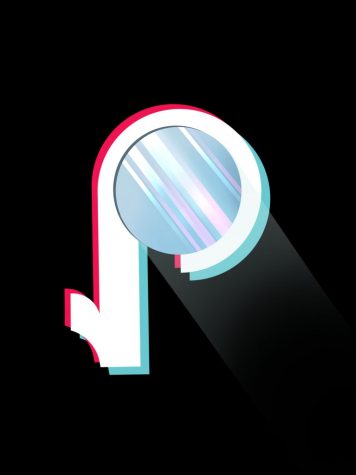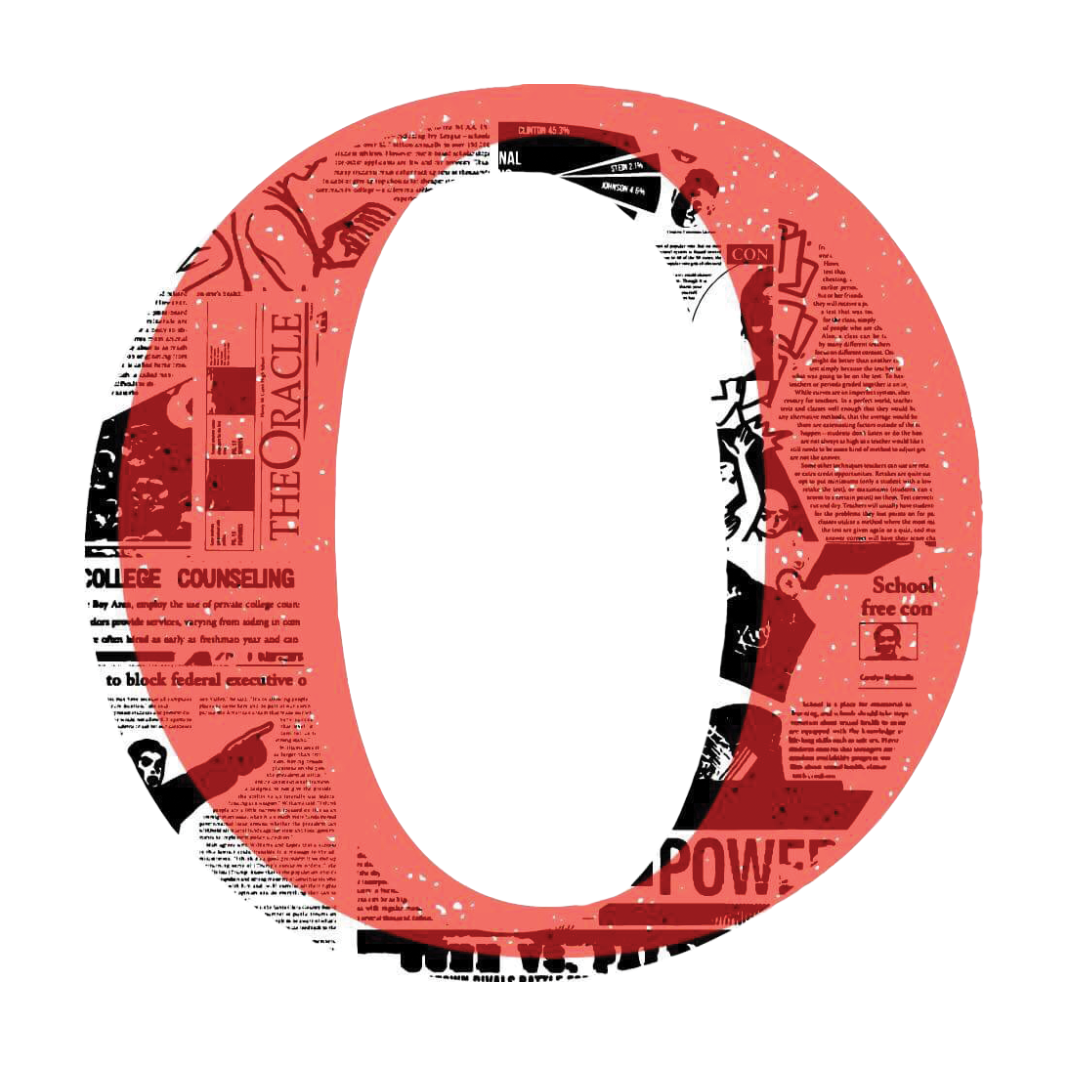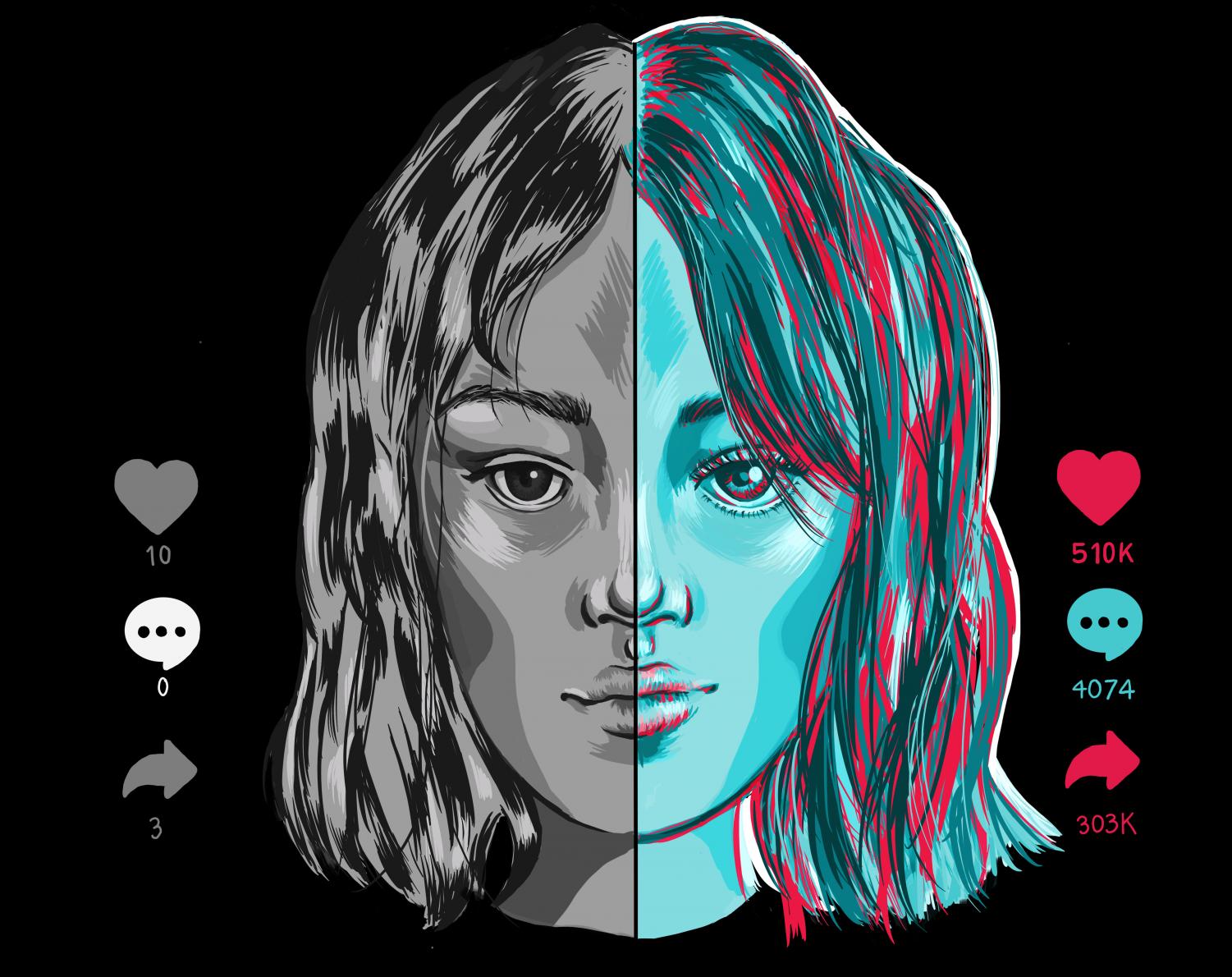Through the looking glass: TikTok pushes a skewed beauty standard to new heights–and onto teens’ screens
February 18, 2021
TikTok has taken over the world. The app has become so ubiquitous among younger generations that the platform, which consists of five to 60 second videos of everything from comedy sketches to dance routines, rarely bears explanation. With over 2 billion downloads and 800 million active users, the app is the most downloaded app in the App Store. So just why is TikTok so popular, and why is it so much more popular than other social media apps?
For one, TikTok content is easily digestible. It’s easy to create an account, and an endless stream of videos will appear on a custom-tailored For You page, even if a user doesn’t choose to follow anyone. This For You page is one of the main draws of the app. “This feed is powered by a recommendation system that delivers content to each user that is likely to be of interest to that particular user,” ByteDance, TikTok’s parent company, said in a press release explaining the app’s algorithm. “Part of the magic of TikTok is that there’s no one For You feed—while different people may come upon some of the same standout videos, each person’s feed is unique and tailored to that specific individual.”
The “tailored” TikTok algorithm, however, belies a darker reality. In the past, TikTok has admitted to blocking videos created by individuals with facial disfigurements, autism and Down Syndrome from appearing on the For You page. Last year, “The Intercept” published a document given to TikTok moderators advising them on content to restrict: “Abnormal body shape, chubby, have obvious beer belly, obese, or too thin (not limited to: dwarf, acromegaly)” was one rule. “Ugly facial looks (not limited to: disformatted faces, fangs, lack of front teeth, senior people with too many wrinkles, obvious facial scars) or facial disformities (not limited to: eye disorders, crooked mouth disease and other disabilities)” was another.
The justification issued by the company is that such content is highly vulnerable to cyber-bullying and the creator—rather than the content—is the focus of the video. Yet, regardless of intention, the end result is the same: the For You page, the heavily visited and viewed centerpiece of TikTok, defaults to promoting content from skinny, attractive and young creators.
A Narrow Beauty Standard
There’s no better place to witness the beauty standards promoted and perpetuated by TikTok than “content houses,” collaborative groups of popular creators working togetherto create videos. The Hype House, boasting alumni such as Charli D’Amelio, the most followed creator on TikTok, and Addison Rae, the second most followed creator on TikTok, had a photoshoot with its original 14 members—all of whom were white and fit a narrow, constrained definition of beauty. Similarly, the Sway House, a content house consisting of 16-to 22-year-old boys, is perhaps most well-known for videos of the creators working out without shirts on and showcasing toned abs.
Not everyone wants to look like that, but then I feel like seeing it over and over drills it into our minds that that’s what we’re supposed to look like.
— senior Hannah Schendel
The trickle-down effect? When ordinary teens scroll through their For You page, the uniform beauty standards scream out at them. For senior Hannah Schendel, who herself boasts close to 30,000 followers on TikTok, the repetitiveness is more than noticeable. “Not everyone wants to look like that, but then I feel like seeing it over and over drills it into our minds that that’s what we’re supposed to look like,” she said.
Sophomore Kyle Reyes also experienced a similar feeling after scrolling past the regularly promoted influencers on his For You page. “All the super famous guys, like the Hype House—I feel like they’re all like the same men, in terms of their build and their hair and their race,” he said. “Every day I would see these guys, and they’d have these perfect bodies. It kind of changed my perception of perfect, and I wanted to look like those guys.”
Every day I would see these guys, and they’d have these perfect bodies. It kind of changed my perception of perfect, and I wanted to look like those guys.
— sophomore Kyle Reyes
As a result, Reyes recently decided to delete TikTok.
Rather than actively taking steps toward diversifying beauty standards that appear on the app, it seems as if TikTok only continues to reinforce a harmful standard on a platform reaching millions.
And, of these millions, it’s the teens who are especially susceptible to self-comparison, according to psychiatrist Maria Daehler.“[Teens] are going through puberty, and sex hormones are creating differences and changes in [their] brains that are causing them to be more aware of their own body,” Daehler said.“There are literally parts of their brains that are changing to be more aware of differences between them and another.”
The popular content that teens witness, for the most part, does not reflect the diversity of bodies in society. “What gives us this standard of beauty doesn’t necessarily tend to be very diverse,” Wellness Outreach Coordinator Rosie Castillo said. “I think it does give us a really tiny perception of what’s beautiful and what’s acceptable and what’s normal, and the folks that deviate from that may not necessarily get as much attention, which is unfortunate because really, [social media] should reflect our society just the way that it looks.”
And it’s not like creators are au naturale on TikTok. Before filming a video on TikTok, digital beauty filters may blur a creator’s skin, erase away any blemishes or pimples, and make the lips appear larger while whitening their teeth and altering their face shape. A clear message is sent: in order to be considered “beautiful,” lips should be bigger, skin clearer and the face skinnier.
Such filters reflect directly on self-esteem. “‘Are we looking at authentic images reflected back of ourselves?’ is a question we have to ask if we have to put the Zoom makeup fixer on our face every morning,” Daehler said. “If I’m putting it on because I think that I need to look better than who I am, that speaks to low self-esteem, and we internalize that more and more.”
If I’m putting it on because I think that I need to look better than who I am, that speaks to low self-esteem, and we internalize that more and more.
— psychiatrist Maria Daehler

Unplugged From Reality
The COVID-19 pandemic, predictably, has only worsened the discrepancy between beauty on TikTok and beauty in reality. When students cannot interact with each other in person, the only main exposure they get to other teenagers is through social media, especially TikTok. Senior Shira Tamler, a frequent TikTok user, noted how social media has impacted her self-confidence during the pandemic. “I think [TikTok] gives us really unrealistic self-standards and makes us way too hard on ourselves, especially in quarantine, where you do not see people a lot,” Tamler said. “You’re just with yourself, and thinking about how you look. Being on TikTok kind of makes it a little bit worse because you see all these girls, and you see a lot of people saying really mean things about them.”
Hurtful comments and a general lack of empathy online only worsen the problem. When there is something acutely “wrong” with a person, people in comment sections frequently point it out, and bullying has become a frequent problem. “Sometimes I’ll see someone who’s not traditionally or conventionally ‘pretty,’ but then everyone will be very positive in the comments,” Schendel said. “But then, other times, like I remember seeing this one girl and people thought that her eyes were a little bit far apart, so they just kept commenting that on her post.”
It’s not just the creators who are negatively impacted. “Let’s say there’s this guy,” Reyes said. “He has a perfect body and someone comments, ‘Wow, you look weird.’ People are gonna think that’s not a perfect body. Do I have to do even better than that?”
Schendel has noticed a similar effect from TikTok comments. “I think it could definitely have a really bad impact on people’s perceptions of themselves because of other people making negative comments about their appearance,” she said. “They’ll probably think less about themselves and maybe even develop insecurities that maybe they otherwise wouldn’t have had.”
The end result is a strongly negative atmosphere on the app.“It’s inevitable that you’re going to see a bunch of unrealistic beauty standards and people cyber-bullying each other in the comments,” Tamler said. “At this point, it’s so easy for people to bully others on the app that it’s become normalized.”
It’s inevitable that you’re going to see a bunch of unrealistic beauty standards and people cyber-bullying each other in the comments. At this point, it’s so easy for people to bully others on the app that it’s become normalized
— senior Shira Tamler
It’s also harder to view what’s beneath the surface online. According to a BBC survey of female university students, women reported that they tend to compare their own appearance negatively with both their peer group and with celebrities. The comparison group that had the strongest link to body image concerns, however, were the distant peers, or acquaintances.
In other words, women are often aware of that fact that celebrities’ social media posts are heavily edited to appear artificially “perfect,” while it’s already understood close friends don’t have perfect lives, despite what it might look like online. Yet when it comes to the in-between acquaintances, it’s difficult to perceive the extent of editing tools used—and the artificiality of what’s portrayed—making it easier to force a comparison.
While the effect is sometimes subconscious, the constant reinforcement of a certain beauty standard can have a lasting impact on teens’ perceptions of themselves. Castillo frequently interacts with students and, before the pandemic, watched students engage with TikTok. “The way that [TikTok] has been negatively affecting our students is pretty apparent,” Castillo said. “There are mental health issues that stem from cyberbullying and body-image issues because of what they see online.”
One example? “What I Eat in a Day” videos are a common phenomenon in which users on TikTok share often unrealistic diets and unhealthy weight loss methods. “I think it’s promoting a lot of eating disorder behaviors,” Schendel said. “I see really young girls in some comments be like, ‘I’m not gonna eat today because I don’t look like that.’ It’s definitely very concerning.”
Seeing certain body types on social media can create the perception that there’s an ideal body type for teens. “Social media makes it easier for people to see the wide differences in the way that we look,” Castillo said. “The money that you see YouTubers and Instagrammers spend[ing] on altering themselves to look acertain way—it’s like they’re trying to fit into a mold. And when the user can’t, for whatever reason, it creates some distress. We’ve seen definitely an increase [of distress], and it’s widespread.”
With each passing year, it seems, the age at which children are first exposed to social media becomes younger and younger. On these platforms, kids have access to content past generations certainly never had, but there’s also an immense pressure that their parents didn’t feel. “When [our parents] were our age they got to live more in the moment, and they didn’t have to worry about looking a certain way over social media,” Tamler said.
Part of the pressure adolescent creators feel is to look the way popular, older influencers look, resulting in a skewed perception of what behaviors and appearances are “normal” for any given age group. “There are 13-year-olds who look like they are 20 [on TikTok].” Schendel said. “That is weird for me because I am 17, but I don’t even look like that. So how does a 13-year-old look like that?”
There are 13-year-olds who look like they are 20 [on TikTok]. That is weird for me because I am 17, but I don’t even look like that. So how does a 13-year-old look like that?
— senior Hannah Schendel
Creating New Movements
In the face of all this, new movements are striving to promote different and diverse beauty standards; there has been an increase in social media influencers gaining popularity for their body positivity videos and posts. 16-year-old Sienna Mae Gomez, for example, is known for showing videos of herself after eating, when she’s bloated, or for squishing parts of her body that women are traditionally insecure about—such as stomach rolls and cellulite—in an attempt to normalize such features. Other creators such as Victoria Garrick, a former Division I athlete, frequently discuss taboo subjects about women’s bodies, including counting calories and an “intuitive eating” approach.
Body positivity activists, such as pop singer Lizzo, have also posted videos of their bodies in their natural state to challenge the idea of the “perfect body.” Lizzo recently made a video displaying her body at all angles, discussing her struggles with body positivity and encouraging viewers to accept themselves, no matter their size. “I’m so proud of you for making it this far in a society that gives us a headstart into self-loathing, that hands us a dysmorphic mirror and leaves us desperate to catch up with who we think we should be,” she said.
Besides individual creators, some brands have also shown their support for more inclusive beauty standards. For example, Dove has committed to “always feature real women, never models” in their ads, and launched the Dove Self-Esteem Project, aimed at educating the next generation on body confidence. The American Eagle brand Aerie has also made steps toward promoting women of all body types in their ads and has pledged to no longer airbrush their models.
Daehler thinks that campaigns like these provide a more hopeful outlook for teens.“The more that [girls] click and look at social media, they tend to have a lower sense of [body-image],” she said. “But there are some studies that are suggesting that the way the body is presented on social media can counteract some of that. So, instead of just blocking social media or blocking teens from seeing social media, show multiple different types of bodies and focus more on women’s personality and their intellect and not objectify them so much in terms of just their physical appearance.”
Instead of just blocking social media or blocking teens from seeing social media, show multiple different types of bodies and focus more on women’s personality and their intellect and not objectify them so much in terms of just their physical appearance.
— psychiatrist Maria Daehler
Even though body positivity content is hardly the focus of TikTok—while Gomez has amassed over 14.5 million followers in the last few months and Garrick has 703,000, these numbers are only a fraction of Charli D’Amelio’s 108 million—the steps being made by these creators and brands are showing that there is push for a more diverse idea of beauty on social media.
As for TikTok, viewers are urging the app to highlight all types of creators. “TikTok should promote different body types, different races and pull away from the current standard that’s set in stone,” Reyes said. “What they’re doing right now with only putting muscular, white guys or skinny white girls on the For You pages, is not [acceptable]. They definitely should pull away from that and promote more diverse people in terms of skin, race, body type and content.”

